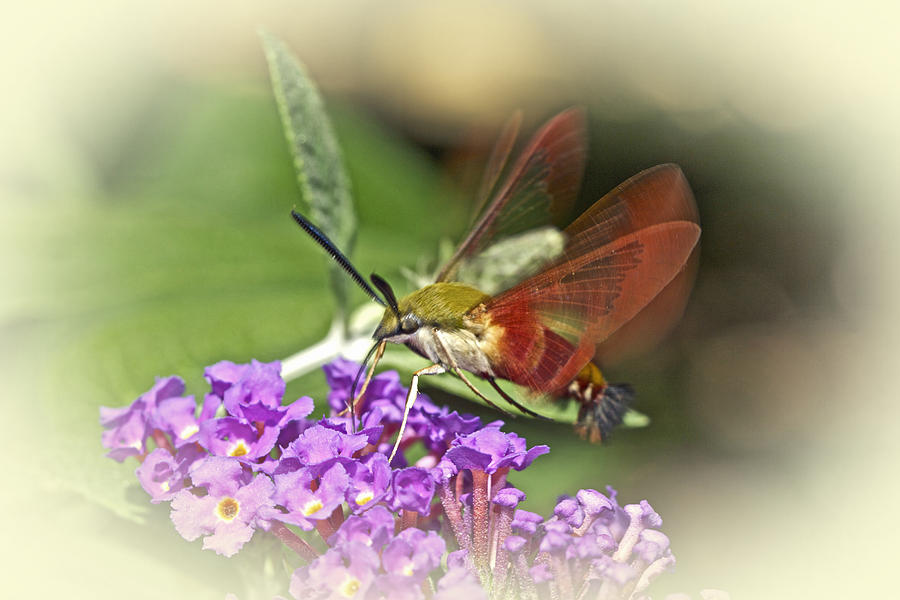
Clearwing Hawk Moth - Hemaris thysbe

by Carol Senske
Title
Clearwing Hawk Moth - Hemaris thysbe
Artist
Carol Senske
Medium
Photograph - Photograph
Description
These moths are strong, fast fliers. They hover like hummingbirds at flowers (usually with one foot resting on the bloom) and sip nectar. I think they look like flying crayfish.
I isolated the moth and added a layer of texture and color.
Here is a nice little write up on them:
http://www.silkmoths.bizland.com/hthysbe.htm
Photographed with a Canon T4i camera and a Tamron 90mm Macro lens f/2.8 1:1
Uploaded
October 24th, 2013
Statistics
Viewed 307 Times - Last Visitor from Ottawa, ON - Canada on 04/25/2024 at 7:44 AM
Embed
Share
Sales Sheet
Comments (8)

Bette Devine
Marvellous macro. I did not know that there were moths that sipped nectar!!!
Carol Senske replied:
Quite a few, actually. Yuccas are pollinated by a moth, for example. It's an amazing process! This info from Google. Yucca Moths (Tegeticula sp.) By Beatriz Moisset Yucca moth is inside the flower of a yucca.This yucca moth is inside the flower of a yucca, Yucca glauca. Photo by Ann Cooper, BugGuide.net. Tegeticula sp.Tegeticula sp. Photo by M.J. Hatfield, BugGuide.net. Yucca moths on a yucca flower.Yucca moths on a yucca flower. Photo by Alan Cressler. Yucca moths on a yucca flower.Yucca moths on a yucca flower. Photo by Alan Cressler. One of the most extraordinary partnerships between an insect and the plant that it pollinates is that of the yucca and the yucca moth. They are so interdependent that one cannot live without the other. Actually, there are a number of species of yucca, each with its corresponding partner, a species of Tegeticula or Parategeticula moth. This mutually beneficial relationship probably started as a relationship of exploitation with the moth feeding on the yucca. This is still the case with a number of close relatives of Tegeticula, members of the Prodoxidae family. The yucca moth is a non-descript, small, whitish moth that blends well with the color of the yucca blossoms where it spends most of its brief adult life. A very distinctive feature of Tegeticula is the absence of the long tongue, characteristic of most moths and butterflies. Instead, it has tentacles around its mouth that serve a very important function and make possible its job as a pollinator. The adult yucca moth does not need to feed because it is so short lived. However, the female gathers pollen, which it holds under its chin with the help of the tentacles. Males and females emerge from their cocoons in the spring in synchrony with the blossoming of the species of yucca with which they are partners. They meet and mate on the yucca blossoms and then the job of the females starts. She visits the anthers of the flower and scrapes the pollen from several of them shaping it into a large lump. Then she leaves in search of another inflorescence, not just another flower in the same bunch but in a different plant altogether, assuring in this manner the cross pollination of the yucca. When she arrives at a new plant, she inspects the flowers and chooses the ones that are at the right stage. She also checks if there are already eggs laid in the flower’s ovary. She can detect the smell of other f...

Brian Tada
Love the wing action in this magnificent and stunning capture, Carol! F/L
Carol Senske replied:
They are something of a challenge but worth the effort:>). I do so appreciate your lovely comment, Brian!

Matthew Livsey
Hi, Mother! You should paint this piece...It is beautiful!!!
Carol Senske replied:
What a lovely thing to say, Matthew! Thanks so much but I have no talent with a brush:>) You paint it! I'd love to see how you'd interpret it.

Laur Iduc
Great shot! L/Fav
Carol Senske replied:
Many, many thanks for your wonderful compliment and the L/F - much appreciated!

Nava Jo Thompson
This is so pretty--great capture---l/v/f
Carol Senske replied:
Hi, Nava Jo! Hope you've been well and busy. Many thanks, my dear, for this vist and all your support - it is valued:>)

Jaclyn Hughes Photography
They are cute lil buggers. I managed to get a few shots of one this summer. They are quick!
Carol Senske replied:
They are such fun to watch and I've never seen them still except one time when one was still groggy in the early morning and sitting on a fern. Thank you for this lovely comment!



















































